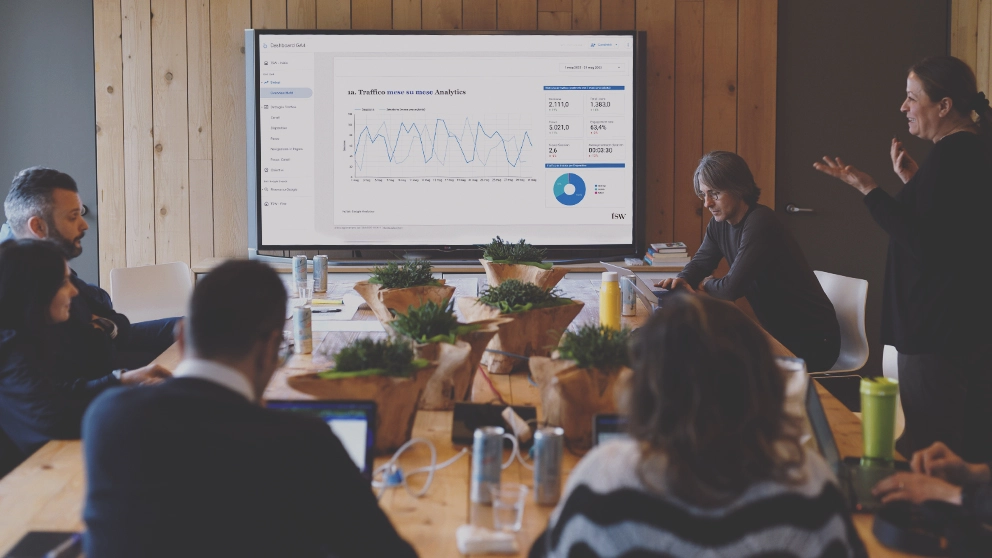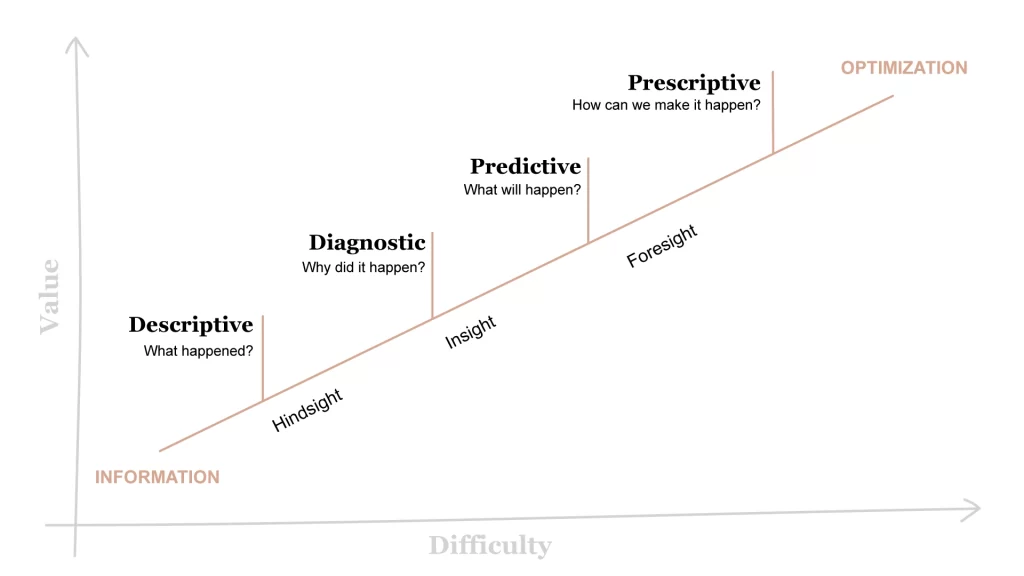How data analytics is transforming the corporate approach to strategy planning and decision making

Data analytics is transforming the business approach to strategy planning and decision making. In the past, companies relied on their intuition and experience to make important decisions, but today, thanks to data analytics technologies, it is possible to make decisions based on data. Two data analytics techniques that are becoming more common are predictive and prescriptive analytics.
What is Predictive Analytics?
Predictive analytics is a set of statistical and artificial intelligence techniques that allow you to analyze historical data and use this information to predict the future behavior of a system. In other words, predictive analytics tries to extrapolate mathematical models from existing data to make predictions about the future.
Predictive analytics is divided into two main phases: the first phase consists of acquiring and analyzing data, while the second phase concerns the construction of the predictive model. In the first step, the data is collected, cleaned, normalized and analyzed in order to identify any patterns or relationships between the variables under examination. Subsequently, in the second phase, machine learning or artificial intelligence algorithms are used to create the predictive model. For further information, we refer you to our article on predictive models.
In practice, predictive analysis can be applied to many fields of activity, from finance to production, from marketing to human resource planning; for example, in the financial sector, to predict market fluctuations, the interest rate or the price of shares; in the insurance sector, to estimate the risk of an accident or illness; or in the marketing and advertising sectors, to predict consumer choices and to personalize commercial offers.
Predictive analysis represents a great opportunity to improve the efficiency and effectiveness of companies, as it allows you to anticipate market trends, optimize production processes and prevent management problems. However, predictive analytics requires advanced knowledge of statistics and machine learning or artificial intelligence algorithms, as well as a large amount of data. Furthermore, the accuracy of the predictions depends on the quality of the input data and on the choice of the most suitable algorithms for the specific application.
The importance of prescriptive analytics for business optimization
Prescriptive analytics is one of the most advanced forms of data analytics and can be used to examine a wide variety of business problems including trading algorithms, supply chains, human resource management. It allows you to provide recommendations and suggestions proactively, i.e. before an event or problem occurs.
In essence, prescriptive analytics is based on the use of complex algorithms that process large amounts of data to generate predictions and recommended activities. In this way, prescriptive analytics differs from predictive analytics techniques because it goes beyond its historical data, which is limited to identifying trends and possible future scenarios.
The objective of prescriptive analysis is to suggest a series of actions that can be adopted by a company or an individual to improve its results or optimize its performance, in order to maximize the value of the activity performed.
In the business field, prescriptive analytics can be used for multiple purposes, such as to optimally meet customer needs, increase the efficiency of production processes, improve marketing strategies or identify business development opportunities.

An example of prescriptive analysis could be that of a supermarket chain which, based on historical sales data, is able to predict which product will be purchased by a specific customer at a specific time and to suggest personalized offers and promotions.
However, prescriptive analytics requires a large amount of data and expertise in processing the information available, which can be a challenge for companies that do not have the necessary in-house tools or resources to make best use of them. It is therefore essential that companies invest in advanced technologies, but also in staff training, to ensure a correct application of prescriptive analytics and optimize the value of the information acquired.
Predictive and prescriptive analytics in marketing: how to make informed and better business decisions
Predictive and prescriptive analytics are very useful tools for marketing, as they allow you to identify market trends and help companies make informed decisions.
Predictive analytics relies on analyzing historical data and market trends to predict future customer behavior and satisfaction levels. This type of analysis can help businesses identify new market segments, improve retention of existing customers, and improve conversion rates.
Prescriptive analytics, on the other hand, offers solutions to problems identified by predictive analytics, suggesting the best actions to take to achieve marketing goals. This type of analysis can be used to choose the right pricing strategy, to optimize advertising campaigns (optimization algorithms can be used to identify the optimal combination of marketing channels to reach the desired customers) and to improve the experience of the clients.
Businesses can use predictive and prescriptive analytics to improve their conversion rates, increase customer loyalty and reduce marketing costs. For example, a business can use predictive analytics to identify which customers are most likely to make a purchase and use prescriptive analytics to suggest related products or offer them personalized coupons.
At TSW we often carry out mainly prescriptive analyzes for our customers, with the aim of providing advice on strategic activities and optimizations based on the data collected, both in the continuous consultancy phase and through the sharing of ad hoc reports.
Revolutionize manufacturing management through predictive and prescriptive analytics
Predictive and prescriptive analysis is revolutionizing production management, giving companies the ability to anticipate market needs and optimize the production process.
Predictive analytics leverages historical data processing to identify patterns and trends, which can be used to predict future production behavior. Thanks to the use of machine learning and artificial intelligence algorithms, companies can make informed decisions on production planning, warehouse and raw material inventory management, plant maintenance and logistics flow management.
Prescriptive analytics goes beyond simple forecasting as it enables companies to plan for the future of manufacturing. Through the computer simulation of different scenarios, prescriptive analysis helps to identify the best approach and the best production sequence, improving efficiency and reducing waste of time and resources.
Predictive and prescriptive analytics are particularly important in technology-intensive sectors, such as the manufacturing industry, where the ability to manage the production process in a precise and timely manner can determine the company’s competitiveness on the global market.
The ability to predict and plan the future of production allows companies to quickly adapt to market evolutions and changes in the economic environment, positioning themselves ahead of the competition.
HR planning: the precious support of predictive and prescriptive analytics
The use of predictive and prescriptive analytics in human resource planning helps companies identify future needs of the labor market and their businesses, facilitating long-term resource planning and avoiding hasty decisions or decisions based only on knowledge of the last minute.
One of the most common ways to use predictive analytics in HR planning is to monitor demographic and market data, such as workers’ age, education, and preferences for flexible working. This allows companies to identify and promote emerging skills and talents, attracting the attention of the workers who are best suited to their activities.
In addition to this, prescriptive analytics helps companies develop specific strategies to address specific problems such as increased staff turnover, shortage of skilled workers or high absenteeism rates.
Additionally, prescriptive analytics can be used to identify the most effective hiring and people development patterns. This enables companies to take a strategic approach to HR planning, training planning and staff turnover planning by analyzing past performance and labour market trends to make smarter, well-informed decisions.
The future of predictive and prescriptive analytics
In the future, predictive analytics is expected to become even more sophisticated and accurate through the use of technologies such as deep machine learning (deep learning) and natural language processing (NLP). This will make it possible to predict the future with greater precision and speed, both in business contexts (for example sales forecasts) and social contexts (for example epidemic forecasts).
Predictive and prescriptive analytics are increasingly becoming two interrelated processes. Real-time data processing and decision-making automation can provide specific suggestions to improve business effectiveness and human performance.
In summary, predictive and prescriptive analytics is evolving towards a level of sophistication never seen before, characterized by the use of emerging technologies that expand the possibilities of application in different business and social contexts, leading to significant changes in the way we predict and act.